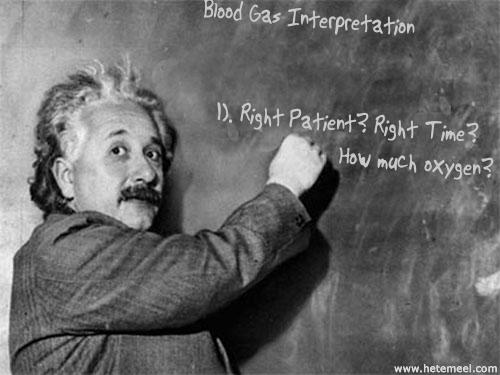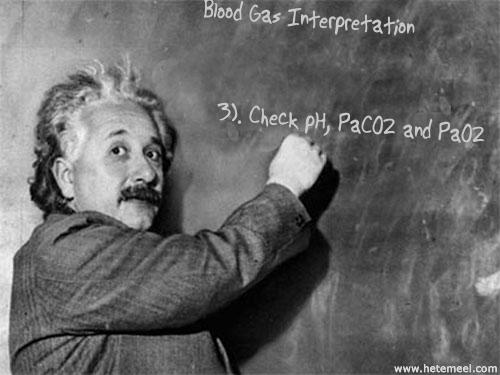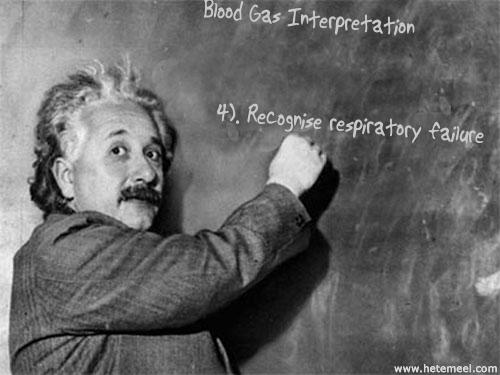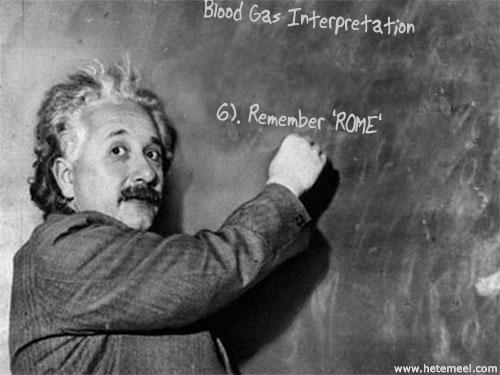Life's A (Blood) Gas
Just as with ECGs arterial blood gases (ABGs) are an essential part of Medicine and unavoidable. They're a vital part of assessing the unwell patient.
Unfortunately students are often quite blood gas-phobic and this needs to be overcome and hopefully with a stepwise approach we can all learn to love the blood gas! Once again I'll be enlisting the help of Albert Einstein and his chalkboard - the meme generator can be found here.
It's worth saying that ABGs are not nice to receive and so think if you really need to do one or if you could get away with a venous blood gas (VBG). A VBG will give you a reliable pH, bicarbonate, electrolytes, glucose and lactate as well as carbon dioxide if it's normal. ABGs are really good for determining the oxygen partial pressure however. Life in the Fast Lane has a brilliant blog on the subject of VBG vs ABG. This blog will mostly focus on ABGs.
So as ever make sure the gas in your hand is from the right person at the right day and time and look at how much oxygen the patient is on. This is the amount of inspired oxygen or fraction of inspired oxygen (FiO2) the patient is receiving. The delivery device being used by the patient will tell us their FiO2.
Room air at sea level has a FiO2 of 21%.
Photo by Liuhsihsiang/iStock / Getty Images
The next oxygen delivery is nasal cannulae which are only good at delivering 1-4L/m of oxygen - beyond that the patient won't have any benefit and have very turbulent air up their nose! The FiO2 of oxygen delivered by nasal cannula is as follows:
1 L/m = 24%
2 L/m = 28%
3 L/m = 32%
4 L/m = 36%
The next oxygen delivery system to look at are Venturi masks; these deliver a guaranteed FiO2 of oxygen and are brilliant at titrating oxygen to patients especially patients with COPD.
Photo by porpeller/iStock / Getty Images
The Venturi come in different colours and will have the FiO2 written on their side as well as the l/min that are needed to provide that FiO2. Make sure they have the correct flow rate or they won't work. The range available will vary site to site but in the department I work at the Venturi available are 24%, 28% & 40%.
The next highest oxygen delivery system you'll commonly see are non-rebreather masks (NRM).
Photo by Image Source/Stockbyte / Getty Images
"15 litres through a non-breather mask" is a very common statement in an acute A-E station. It's less easy to predict the FiO2 here only that is is somewhere between 60-100%.
Make sure the FiO2 or oxygen delivery is documented on the gas.
pH: 7.35 – 7.45 (pH messages the amount of Hydrogen ions in a solution (in this case blood) the lower the pH the more acidic the blood, the higher it is the more alkalotic it is)
There are two main components contributing to the pH - the respiratory side (CO2) and metabolic (Bicarbonate). A problem with one can be compensated with the other - more of that later.
PaCO2: 4.7-6.0 kPa (Pa stands for Partial Pressure - the amount of pressure the gas in question contributes to the atmosphere measured in kilo Pascals. CO2 is acidic when dissolved in solution. Increasing respiration rate blows off CO2 while reducing respiration rate means we retain CO2. Normally PaCO2 is what drives our ventilation; this is not the case in chronic CO2 retention such as COPD where hypoxia then drives respiration)
PaO2: 11-13 kPa (if this is low then the patient is hypoxia - this is cause of cardiac arrest and so must be identified early)
HCO3-: 22-26 mEg/L (Bicarbonate is basic and so is used as a buffer against acid. Increasing the amount of bicarbonate however takes hours to days whereas it's almost instantaneous to alter respiration rate)
Base excess: -2 to +2 mmol/L (this is measure of the metabolic component of a problem with the pH. If the BE is below -2 then the patient has a base deficit and so has metabolic acidosis. If the BE is above +2 then the patient has a base excess and a metabolic alkalosis
Once you're happy with the ABG being for the right patient etc it's now time to first look at the pH - is it normal, high (alkalotic) or low (acidotic)?
Is the CO2 normal, high (hypercapnic) or low (hypocapnic)?
Is the O2 normal, high (hyperoxic) or low (hypoxic)?
At this point we need to remember the Alveolar-arterial (A-a) gradient. This is the gradient between the PaO2 of inspired air and that in the blood. In a healthy adult it should be about 5-10mmHg. That means the PaO2 on your ABG should be about ten less the FiO2, hence why in room air (FiO2 21%) the normal range of PaO2 is 11 - 13 kPa.
A-a gradient is accurate up until FiO2 of about 60% and over. Why is it important? Well, you could have a patient on a 28% Venturi with normal saturations but if their PaO2 is less than 18 kPa (say 12 kPa) then they have relative hypoxia and we should be more worried about them and make sure they are getting senior support.
If the patient is hypoxic check the PaCO2 again
If PaO2 is low and PaCO2 is low or normal then the patient has Type 1 Respiratory Failure - the lungs are failing in the function of taking O2 from the air to blood
If the PaO2 is low and PaCO2 is high then the patient has Type 2 Respiratory Failure - the lungs are failing in getting O2 from the air and removing CO2 from the blood. This may be acute, chronic or acute on chronic. The raised PaCO2 will lower pH acutely; the blood will respond by buffering this by increasing bicarbonate production in the kidneys. This process takes days to hours. Patients may walk around with a fully compensated Type 2 Respiratory Failure (such as COPD) but then decompensate and become acidotic again despite the raised bicarbonate - acute on chronic failure
Acute Type 2 Respiratory Failure (no compensation):
pH 7.2
PaCO2 10
Pa O2 7
Bicarbonate 24
Chronic Type 2 Respiratory Failure (fully compensated):
pH 7.39
PaCO2 10
PaO2 7
Bicarbonate 30
Decompensated Chronic Type 2 Respiratory Failure (Acute on Chronic):
pH 7.28
PaCO2 11
PaO2 6.8
Bicarbonate 30
Causes of Type 2 Respiratory Failure can be pulmonary (such as COPD); peripheral (such chest wall deformities or peripheral nervous diseases such as Motor Neuron Disease) or central (such as overdose of opiates or benzodiazepines causing respiratory depression)
So now we know the values for pH, PaCO2, PaO2 and Bicarbonate it's now time to put it together and identify whether it is a Respiratory or Metabolic cause for pH disturbance
I use the mnemonic 'ROME'
The problem is Respiratory when the PaCO2 is Opposite to pH
The problem is Metabolic when the bicarbonate (HCO3-) is Equal to pH
I find this is a very quick way of identifying the cause, being aware of course that you can have mixed acidosis (due to combined high PaCO2 and low bicarbonate) and mixed alkalosis (low PaCO2 and high bicarbonate)
If the problem is respiratory then there will be metabolic compensation (compensating high PaCO2 with high bicarbonate and vice versa) - this takes a long time remember
If the problem is metabolic then there be respiratory compensation which is much quicker
Compensation can be none, partial (there is an attempt but pH remains deranged) or full (pH back within normal limits)
Remember that there are other bits of information on an ABG
Sodium
Potassium - if deranged do not wait for serum U&Es before commencing treatment
Calcium
Chloride
Glucose - while BM machines will just say 'HI' once BM ~30 the ABG will measure up to about 50
Lactate - important measure of tissue perfusion
Haemoglobin - not entirely accurate but will give an idea of anaemia/bleeding
Carboxyhaemoglobin
It is important not to miss this information as well!
There is a brilliant RCEM module on ABGs here.
Check out the brilliant Geeky Medics page on ABG interpretation here.











